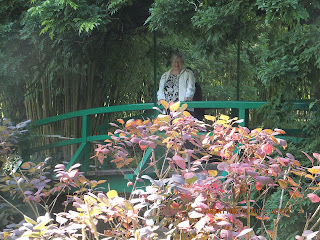The Bayeux Tapestry was mind-boggling. You can read about this incredible tapestry, but 70 metres long doesn't really sink in until you walk slowly past it. (Another clever logistical device here. You are given an audio guide with your ticket, and the pause button is disabled. So you're sort of forced to go along at the rate of the narration. The French speakers seemed to move more slowly, so I guess the English was a faster narration. With a big bus tour there, we had to skip ahead and find a way to peek in. Still, the view was really quite good.)
The tapestry is actually nine pieces of embroidery and its stitches provide a fulsome tale of how William the Conqueror came to rule England (told, of course, from the point of view of the victor). The tapestry is unbelievably well-preserved. There was a museum as well, which told more about the history and daily living of the time and a bit about the stitches used. As someone interested in knitting, crocheting and embroidery, I would have liked to learn more about the needlework, and how multiple people worked on the tapestry at one time.

We ate dinner in a lovely restaurant on the river by the museum. As was our custom in Normandy, we ate gallettes (the buckwheat crepes with savoury fillings) for main course and crepes (with sweet fillings) for dessert, with Normandy cider for accompaniment. As we heard the many American voices around us, we realized that Bayeux was a tourist destination not just because of the tapestry but as a jumping off point for touring the landing beaches from WW II. It was the greatest density of American tourists we'd seen.
The big thrill of the evening was seeing the Bayeux cathedral lit up as we walked back to the car and came upon the Bayeux Cathedral dramatically lit up. This picture doesn't capture the magical quality but it's the best I could do!

The church was very impressive in daylight as well, although the interior was not as interesting as the many churches we'd already seen.
As we left Bayeux, we decided to take the coastal road to look at the beaches where the Normandy landings took place. The beaches went for miles, much more dispersed than I had realized.

























